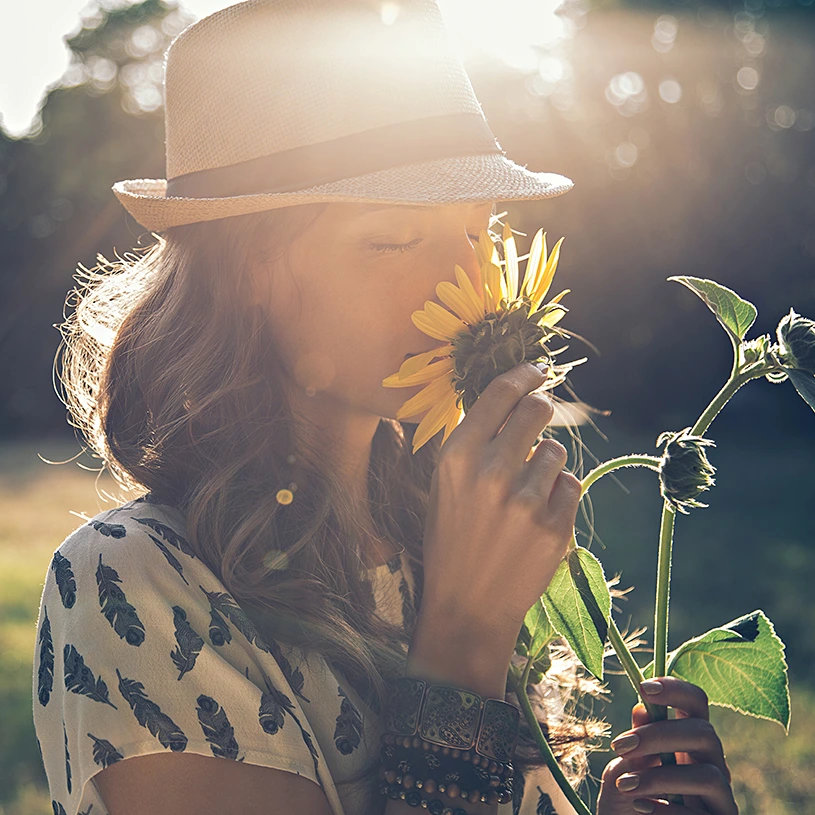알레르기엔 알레그라® | 실외 알레르기비염의 원인, 증상 및 완화
꽃가루 알레르기 증상, 알레르기 종류

다양해요! 알레그라®와 함께 실외 알레르기 비염 완화
봄철만 되면 콧물, 재채기가 멈추지 않나요? 꽃가루 알레르기는 봄철 가장 흔한 알레르기 종류 중 하나인데요, 실외 알레르기 비염의 주요 원인이기도 합니다.
알레그라®와 함께 실외 알레르기 비염의 원인, 증상, 완화 방법에 대해 자세히 알아보고, 꽃가루 알레르기 걱정 줄인 멋진 하루 보내기!
건초열이라고도 불리는 알레르기비염은 환자 수만 성인 192만명, 어린이 52만 명에 이릅니다.
가장 흔한 실외 알레르기비염 유발요인은 꽃가루입니다. 나무, 잔디, 잡초가 수정을 위해 배출하는 가루 물질입니다.
초봄이 되면 나무 꽃가루가 사방으로 날립니다. 늦은 봄과 초여름엔 잔디 꽃가루가 날리고, 늦은 여름과 초가을엔 잡초 꽃가루가 날립니다. 하지만 이 꽃가루들도 지역, 기후 및 주변 식생에 따라 다른데, 온대 기후에선 수분(꽃가루받이)이 일년 내내 날리기도 합니다.
이 기사에서는 다음의 정보를 확인하실 수 있습니다.
꽃가루 알레르기 증상, 혹시 나도 알레르기? 알레르기 종류와 예방법 알아보기!
실내 알레르기와 또 다른 실외 알레르기. 봄철만 되면 콧물, 재채기가 멈추지 않고, 눈이 가렵고 눈물이 흐르나요? 혹시 꽃가루 알레르기는 아닌지 의심해 볼 필요가 있습니다. 꽃가루 알레르기는 알레르기 비염의 가장 흔한 원인 중 하나이며, 건초열이라고도 불립니다. 국내 알레르기 비염 환자 수는 성인 192만 명, 어린이 52만 명에 이를 정도로 흔한 질환입니다.
알레르기 비염은 꽃가루 뿐만 아니라 다양한 알레르기 종류 에 의해 발생할 수 있습니다. 알레르기 종류와 증상을 제대로 알고 알레그라® 와 함께 알레르기 비염을 예방하고 관리해 보세요!
알레르기비염이란 무엇인가요?
특정 계절이나 환경에서 콧물, 재채기, 코막힘 등의 증상으로 고생하고 계신가요?
그렇다면 알레르기 비염일 가능성이 높습니다. 감기 아닙니다. 알레르기 반응은 면역체계가 알레르겐에 반응한다는 뜻으로, 알레르겐은 기본적으로 자극물입니다. 알레르기 비염은 면역 체계가 꽃가루, 먼지, 동물 털 등 알레르겐에 과민 반응하여 발생하는 질환입니다. 면역 체계는 외부 유해 물질로부터 몸을 보호하지만, 알레르기 비염 환자의 경우 무해한 알레르겐에도 과민 반응을 일으킵니다.
신체는 알레르겐에 반응하는 순간 면역글로불린 E(IgE)이라는 항체를 생성합니다. 면역글로불린 E는 몸에서 알레르겐을 제거하기 위해 세포로 하여금 화학 물질을 분비하도록 유발합니다.3 재채기, 기침 및 충혈 등 모든 알레르기비염 증상은 신체의 자가 방어를 보여주는 증거입니다.
실외 알레르기비염의 발현 및 증상
공기 중에 떠다니는 꽃가루가 많아지면 알레르기 반응도 늘어날 수 있습니다. 신체는 어떠한 종류의 꽃가루에도 알레르기 반응이 생길 수 있으며, 다양한 종류의 꽃가루 수가 변이를 거듭하면서 알레르기 반응이 유발될 수 있습니다.3
콧물
눈 가려움 및 눈물
재채기
코막힘
코 가려움
실외 알레르기비염의 대처법
실외에서 꽃가루를 피하긴 매우 어렵지만, 대처할 수 있는 몇 가지 방법이 있습니다.
1. 꽃가루 피하기
- 꽃가루 농도가 높은 날에는 외출을 자제하세요.
- 외출 시에는 마스크와 안경을 착용하여 꽃가루와 접촉을 최소화하세요.
- 꽃가루가 많은 오전 11시부터 오후 3시 사이에는 주의가 필요합니다.
2. 청결 유지
- 외출 후에는 옷을 갈아입고 샤워하여 몸에 붙은 꽃가루를 제거하세요.
3. 실내 환경 관리
- 창문과 문을 닫아 꽃가루가 실내로 들어오는 것을 막으세요.
- 공기청정기를 사용하여 실내 공기를 깨끗하게 유지하세요.
- 알레르기 및 천식 방지 인증 필터가 장착된 제품을 사용하는 것이 좋습니다.
4. 생활 습관 개선
- 잔디 깎기, 낙엽 치우기 등 꽃가루에 노출될 수 있는 작업은 피하세요.
알레그라®와 함께 알레르기 비염 걱정 끝
*알레르기비염 증상 완화
알레그라®는 실내/외 모두에서 나의 행복한 일상생활을 위해 도움을 줍니다. 즉, 알레그라®는 현대인의 삶의 질 향상에 도움을 주는 알레르기비염 약입니다.
3세대 항히스타민제인 알레그라®는 효과가 빠르고 졸음 유발이 적으며 최대 24시간 동안 약효가 지속되었습니다. 만일 코막힘, 콧물, 재채기, 눈/코 가려움증 등으로 인해 불편함을 겪고 있다면 알레그라®가 여러분의 알레르기비염 증상 완화에 효과적으로 도움이 될 수 있습니다.
알레그라®는 3세대 항히스타민제로, 콧물, 재채기, 코막힘, 가려움 등 알레르기 비염 증상을 효과적으로 완화합니다.
※3세대 성분들의 경우, 2세대의 개선 성분으로 2세대에 포함시키는 경우도 있습니다.

알레그라® 제품 알아보기
- 알레그라® 정 120mg: 성인 및 12세 이상 청소년을 위한 알레르기 비염 치료제.
- 알레그라® 츄어블정: 씹어먹는 타입으로 어린이도 쉽게 복용 가능. ※ 국내 출시 예정
알레그라® 를 지금 바로 만나보세요.
1. Asthma and Allergy Foundation of America, Editors. Allergy Facts and Figures, Asthma and Allergy Foundation of America (aafa.org), 2021. Reviewed on Oct. 5, 2021.
2. Andrew Moore, MD, Reviewed. Outdoor Allergens, American Academy of Allergy, Asthma & Immunology (aaaai.org), September 28, 2020. Reviewed on Oct. 5, 2021.
3. Andrew Moore, MD, Reviewed. Seasonal Allergies, American Academy of Allergy, Asthma & Immunology [acaai.org], December 28, 2017. Reviewed on Oct. 5, 2021.
4. Andrew Moore, MD, Reviewed. Indoor Allergens, American Academy of Allergy, Asthma & Immunology [aaaai.com], February 28, 2020. Reviewed on Oct. 5, 2021.
5. Jonathan Corren, MD. Allergic rhinitis: Treating the adult, The Journal of Allergy and Clinical Immunology, June 1, 2000. Reviewed on Oct. 5, 2021.
6. Olasińska-Wiśniewska A, et al. Postepy Dermatol Alergol. 2014;31(3):182-6.
7. Bousquet J, et al. Nat Rev Dis Primers. 2020;6(1):95.
8. Mark E. Efficacy and tolerability of 2nd and 3rd gen antihistamines (2010)
9. Day J H, et al. Ann Allergy Asthma Immunol. 1997;79(6):533-40.
10. Smith S M et al. Expert Opin Drug Metab Toxicol (2009)
11. Peter H the efficacy and safety of fexofenadine and cetirizine in seasonal AR
12. 식품의약품안전처. 의약품통합정보시스템. 알레그라정120밀리그람 (Accessed December 15. 2021. https://nedrug.mfds.go.kr/pbp/CCBBB01/getItemDetail?itemSeq=199801016).
15. Allergies and Exercising Outside https://www.webmd.com/allergies/allergies-and-exercising-outside